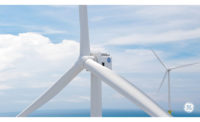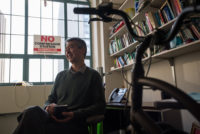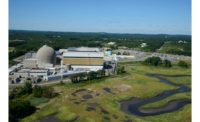Digging Deeper | Water/Environment
Pump Station Will Cut City's Sewage Overflow

The York Street Pump Station and Connecticut River Crossing is located on the east side of the Connecticut River in Springfield, Mass.
Photo by Ryan M. Schmitt, courtesy of Daniel O'Connell's Sons
When Daniel O’Connell’s Sons won the construction contract in 2018 for the $122-million York Street Pump Station and Connecticut River Crossing project in Springfield, Mass., the owner’s designer, Kleinfelder, suggested pipe jacking to launch three new wastewater conveyance pipelines at the pump station that would run under a railroad and flood wall before crossing the river and passing through a levee to the Springfield Water & Sewer Commission treatment facility in Agawam, Mass. That would involve installing a pipe jacket on each side of an active Amtrak commuter rail corridor and jacking two 36-in.-dia force main pipelines and one 72-in.-dia siphon pipe under the railroad and the U.S. Army Corps of Engineers flood wall before launching them from a dry cofferdam receiving pit near the east riverbank, recalls Jeff Weinman, project executive for O’Connell’s Sons, the project’s Holyoke, Mass.-based general contractor.
Once into permitting, however, the plan dissolved because it would require a receiving pit on the river from a barge, which was not possible without a lengthy and costly process. “Access would be difficult installing a receiving pit from a barge since water levels have been so low,” Weinman says. The pipe-jacking option would also require two access points with a launch shaft in the same position as the tunneling access shaft and a receiving shaft in the river, he says.
Instead, O’Connell’s Sons tunneling subcontractor, SECA Underground Corp., proposed extending the length of the tunnels so the project’s microtunnel boring machine could drill underwater through the riverbed slope without need for a receiving pit. Unlike pipe jacking, this solution did not require ground improvements or support excavation for building a receiving pit to recover the machines, Weinman says. The site’s soil conditions only required local soil stabilization at the launch shaft to tunnel while pipe jacking required “soil stabilization along the entire length of the pipeline,” he says.
.jpg)
York Street Pump Station is designed to pump 62 million gallons per day compared with 35 mgd for the existing facility, reducing combined sewage overflows by an estimated 100 million gallons per year.
Photo by Johanna Knapschaefer for ENR
While the planned start for microtunneling was early September, SECA Underground didn’t start the tunnel until mid-November, “leaving the project nearly three months behind schedule,” Weinman says. “Time will be made up to the extent possible by accelerating or adjusting the sequencing of successor activities.” He says they remain “on track to hit the project budget” with the CM at-risk delivery protecting the owner from any cost increases.
Aside from less preparatory work required, microtunneling also “poses less of a risk to nearby critical infrastructure than pipe jacking,” says Gus O’Leary, Kleinfelder principal engineer and technical lead for the river crossing and treatment plant improvements on Bondi’s Island in Agawam. Sinkholes and ground loss are less likely, and there’s “less risk of losing our line and grade while working beneath the tracks and flood wall,” he adds. O’Leary called the tunneling method “a big win for the commission” as the team was able to procure two pipe jacking and one microtunneling proposals … “and allow contractors to bid in the way that made the most sense.”
Set for completion in spring 2023, the plant is located across the river from the more than 80-year-old York Street Pump Station on the river’s east bank. The new plant is designed to pump 62 million gallons per day compared with 35 mgd for the existing facility. Reducing combined sewage overflows (CSOs) by an estimated 100 million gallons per year with 100 fewer discharge events, the increased pumping capability “will reduce the risk of discharging or overflowing the system into the river during major storm events,” says Bill Fuqua, Springfield Water & Sewer Commission director of wastewater treatment.
Aside from the new sanitary pump station and screening facility, construction will include installation of two 36-in.-dia force mains and one 72-in.-dia siphon line laid in the riverbed. They will connect the pump station to the existing Springfield wastewater treatment plant facility on the river’s west bank in Agawam.

The project team extended the length of the tunnels so the microtunnel boring machine could drill through the riverbed slope underwater without need for a receiving pit.
Photo by Johanna Knapschaefer for ENR
Firsts
The complex project is one of the first horizontal pipeline projects in Massachusetts to warrant an alternative delivery method. Most previous commission projects in the state have been procured through design-bid-build, says Jason Lavoie, Kleinfelder project manager and program engineer. The pump station originated as a CSO effort based on a 2014 U.S. Environmental Protection Agency agreement with the commission to address overflows. But the project, which involves the nation’s first integrated wastewater plan based on data-driven strategy to prioritize needs, “quickly morphed into an update of critical infrastructure … more important to the commission,” says Fuqua.
“Micro-tunneling poses less of a risk to nearby critical infrastructure than pipe jacking.”
—Gus O’Leary, Kleinfelder Principal Engineer and Technical Lead
The plan used data from hydraulic modeling of the sewer system and engineering analysis to prioritize projects such as the pump station, which was identified as one that could achieve affordable reduction in CSO volumes as well as replace critical infrastructure. “This is a really important project for the sewer commission and region it serves,” says Johanna Hodge, O’Connell’s Sons project manager. “As one of the larger and more complex projects we have performed in recent years, it will have a significant impact on the community and is beneficial to the river,” she says.
In its second phase of CSO work, the commission has entered the largest phase of its long-term control plan to manage the overflow out to the Connecticut River, says Lavoie.
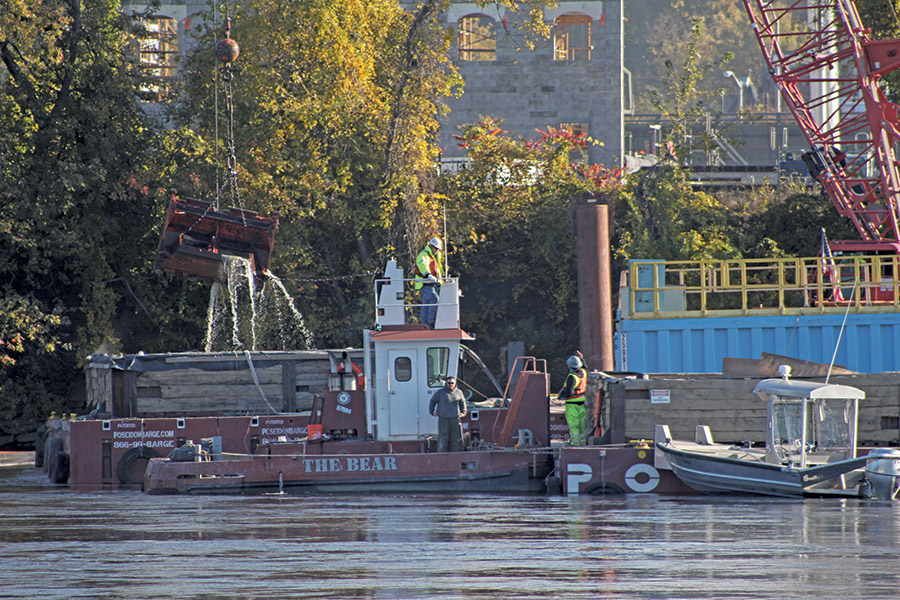
The project’s dredging operation began excavating the 59-ft-wide by 15-ft-deep trench from the east side of the river working toward the west for the pipelines from the pump station to the treatment facility in December 2021.
Photo by Johanna Knapschaefer for ENR
Single Solution
The existing pump station adjacent to the site averages about an 8.4 mgd flow in dry weather, says Emerson Olander, senior associate and technical lead for the pump station at Stantec, Kleinfelder’s subconsultant. The new facility is designed for a peak wet weather capacity of 62 mgd, “an order of magnitude more pumping that we have to be able to handle during relatively common storm events,” such as a monthly or quarterly storm, he says. Often these facilities have dry weather pumps dedicated for smaller flows and wet weather pumps dedicated for large ones. In this case, the team set a goal to develop a single pump to combine those individual pumps to provide the full range of pump station flow, Olander says.
Applied Flow Technology software enabled the team to zero in on the optimal pump selection, using the same model pump to handle all flows eliminated the need for additional structures, electrical systems and space. “Think about all these pumps underground … every time you add a pump, you have a bigger excavation,” he says.
Using hydraulic software, the team optimized the hydraulic design process, Olander says. “It’s a much smaller footprint and … lower cost as a result,” he says. Based on the single-pump selection, “we can get within 5% of the best efficiency of pumps for nearly the entire range of flows that the pump station will see.”
In summer 2019, crews began building a new influent structure as one of the first requirements to handle the new higher-capacity pipelines since the four existing 66-in. influent pipes that enter the plant sit in the same footprint, Weinman says. To bypass those pipes, he says crews took them offline one at a time, installed a temporary gravity bypass with 36-in. ductile iron pipe, took one pipe out of service, put the bypass in and restored service through that pipe, repeating the process with the next pipe, he says.
Once the influent structure was completed in 2020 and gates and controls installed, the team took one bypass pipe offline to restore the flow into the structure before taking the next section offline and tying it into the structure. Assembling and disassembling the 66-in. concrete pipes in proper sequence in the influent’s 10-ft deep trench required “challenging logistics” since the connection point between the new pipes and the adjacent section of bypass piping was only about 2 ft apart horizontally, Weinman says.
Kleinfelder’s O’Leary says in addition to the difficult logistics where the four 66- in. pipes entered the structure’s east side and four pipes exited the west side, a 72-in. pipe and two 42-in. pipes entered the east side and a 24-in. pipe entered on the north. “All of that has to happen in a 35-ft by 50-ft space—and it all happens on top of each other,” he says. The team collaborated to build a FLOW-3D (Flow Science Inc.) computational fluid dynamic 3D software model to simulate how to build the complicated configuration of pipes.
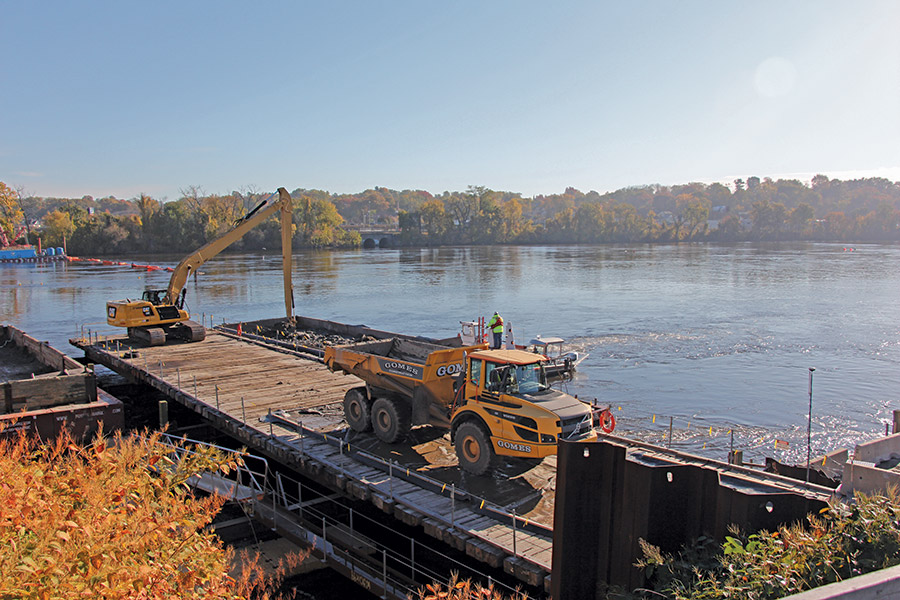
Crews hauled dredged material across the river by barge for removal and temporary storage on site.
Photo by Johanna Knapschaefer for ENR
Permitting challenges
In preparation for the river crossing, the team spent a total of six-and-a-half years permitting the project, Weinman says, coordinating with as many as six state and federal departments that “have to mesh together.”
The team had to comply primarily with EPA and the U.S. Fish & Wildlife Service on federal Clean Water Act and Endangered Species Act requirements, including regulating the discharge of dredged material. At the state level, the Massachusetts Dept. of Environmental Protection issued a water quality certification permit for river dredging and backfill while the agency also issued a license to the commission to permit temporary structures required for construction as well as the pipelines, Weinman says. “Those have to work in conjunction with the orders of conditions from the cities of Springfield and Agawam since we’re touching both of their shores,” he says.
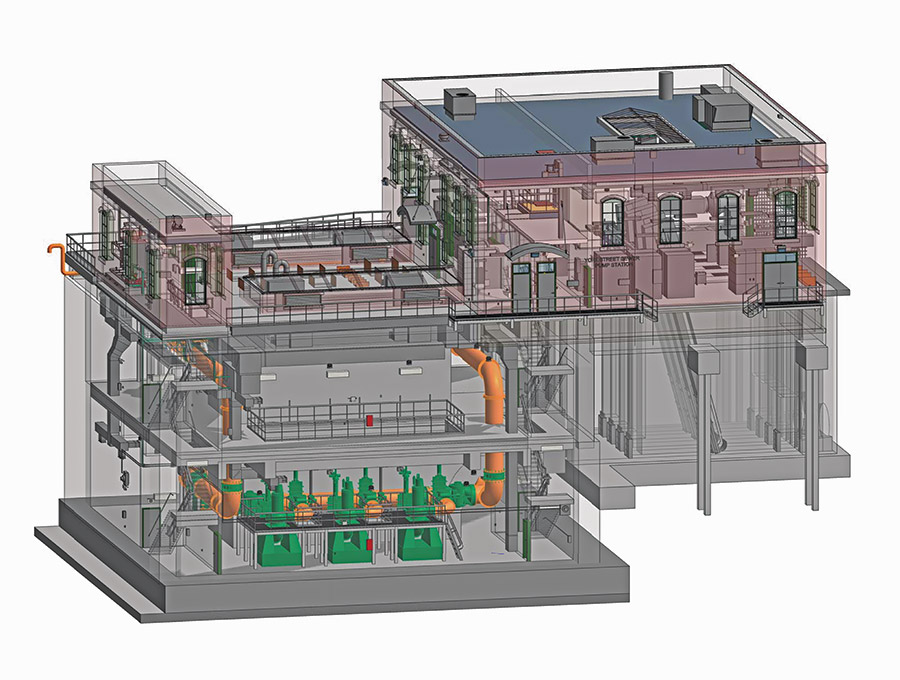
The federated BIM model helped the project team with clash detection and coordination of shop drawings.
Rendering courtesy of Stantec
Dredging supports pipe installation
In-river work began in October with environmental dredging to remove coal tar, a byproduct of gas production from the former Springfield Gas Co., Hodge says. “Crews removed the contaminated soils using a sealed environmental clamshell to contain the material before it was loaded onto lined barges and the runoff water was collected and treated prior to discharging it,” Weinman says.
"The project, which includes the first U.S. integrated wastewater plan, “quickly morphed into an update of critical infrastructure ... more important to the commission.”
—Bill Fuqua, Springfield Water & Sewer Commission Director of Wastewater Treatment
The dredging operation to excavate the 59-ft-wide by 15-ft-deep trench from the east side of the river to the west for pipeline placement then began in December. Divers conducted rigging to retrieve the microtunnel boring machine that will be used to install the pipeline using a joining system called Hydro-Pull, which minimizes the time required for underwater joint assembly. “Essentially each section of pipe is fitted with a bulkhead cap that includes a vacuum system,” Weinman says. “Once the pipe is set in place, they use the vacuum to generate a negative pressure that pulls the piping together. Each joint is then tested and grouted. The cap is removed and affixed to the next section of pipe.”
The divers began laying pipe on Dec. 27. “The river condition is a little higher than typical,” Weinman says, “but there is no ice so far and the flow rate is manageable for the divers.”
Once the overall project is complete, the pipeline will provide system redundancy, Fuqua says. Currently, there are only two vintage pipes that can transport sewer flows from Springfield to the treatment plant. “Until we construct this project, we won’t be able to take one of those two pipes offline to be able to inspect it,” he says. The fate of the existing pipes is uncertain. “Once the new pipes are online, the old river crossing pipes will be cleaned and inspected. Decisions will then be made as to whether the pipes can be rehabilitated for continued use, decommissioned or repurposed.”


